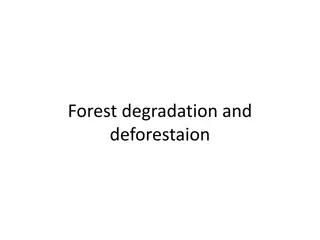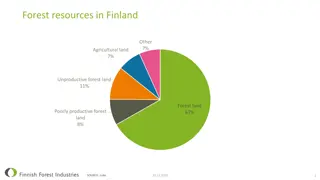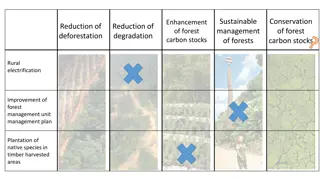Understanding Forest Fires and Their Causes in India
Forest fires have become increasingly common in India, with recent incidents in various states causing significant damage to biodiversity and ecology. Factors such as smoking, campfires, fireworks, burning debris, and natural causes like lightning contribute to the occurrence of these devastating fires. Efforts are needed to address anthropogenic activities and climate change to mitigate the impact of forest fires on the environment and human health.
Download Presentation

Please find below an Image/Link to download the presentation.
The content on the website is provided AS IS for your information and personal use only. It may not be sold, licensed, or shared on other websites without obtaining consent from the author. Download presentation by click this link. If you encounter any issues during the download, it is possible that the publisher has removed the file from their server.
E N D
Presentation Transcript
4thSemester Paper-4016 ENVIRONMENTAL GEOGRAPHY AND DISASTER MANAGEMENT
Forest fire/Wildfire Since the start of 2021, there has been a series of forest fires in the Himachal Pradesh, Nagaland-Manipur border, Odisha, Madhya Pradesh, and Gujarat, including in wildlife sanctuaries. April-May is the season when forest fires take place in various parts of the country. But forest fires have been more frequent than usual in Uttarakhand and have also taken place during winter; dry soil caused by a weak monsoon is being seen as one of the causes. As of 2019, about 21.67% of the country s geographical area is identified as forest, according to the India State of Forest Report 2019 (ISFR) released by the Forest Survey of India (FSI). Tree cover makes up another 2.89% (95, 027 sq km). Forest fire is the uncontrolled fire that destroys large parts of the forest. They are a threat to the fauna and flora and destroy the biodiversity and the ecology of a region. Forest fire causes imbalances in nature and endangers biodiversity by destroying habitats and precious life. Incidents of forest fires have increased in recent years. The main reason for this is climate change fuelled by anthropogenic activity Globally, forest fires release billions of tons of CO2into the atmosphere, while hundreds of thousands of people are believed to die due to illnesses caused by exposure to smoke from forest fires and other landscape fires.
Causes of Forest Fires: Anthropogenic causes (90% of all wildfires) Smoking: Smoking is the leading cause of fires and deaths globally. Habit of smoking while driving, walking or biking and then throwing away the cigarette butts without completely extinguishing it lead to forest fires. Smokers at times become negligent at extinguishing the cigarette butts after smoking. Campfires: During camping or outdoor activities people normally leave lit fires or combusting materials unattended to which ignite wildfires. It is a must for all lit fires and combusting materials to be totally extinguished after use to avoid wildfire disasters. Fireworks: Fireworks are used by humans for various reasons such as festivals. However, their explosive nature can start wildfires.
Burning Debris: Wastes and trash are on several occasions burned to ashes as a way of reducing the accumulation of rubbish. What is left after burning the waste matter or trash is debris that burns slowly. This slowly burning debris can potentially set anything ablaze and start a wildfire because of the heat. In India, forest fires are most commonly reported during March and April, when the ground has large quantities of dry wood, logs, dead leaves, stumps, dry grass and weeds that can make forests easily go up in flames if there is a trigger. A major reason for forest fires in north-east India is slash-and- burn cultivation, commonly called jhum cultivation. The north-east has tropical evergreen forests which are not likely to catch fire easily on their own like the dry deciduous forests of central and southern India.
Natural Causes Lightning: A good number of wildfires are triggered by lightning. A lightning strike can produce a spark. Sometimes the lightning can strike power cables, trees, or rocks and any other thing and this can trigger a fire. Volcanic eruption: Hot magma in the earth s crust is usually expelled out as lava during a volcanic eruption. The hot lava then flows into nearby fields or lands to start wildfires. Heat patterns: Increased temperatures due to global warming are making the forests more vulnerable. Rising atmospheric temperatures and dryness (low humidity) make favorable circumstances for a fire to start.
Why are forest fires difficult to control? The locality of the forest and access to it pose hurdles in initiating firefighting efforts. During peak season, shortage of staff is another challenge in dispatching firefighting teams. Timely mobilization of forest staff, fuel and equipment, depending on the type of fire, through the thick forests, remain challenges. As it is impossible to transport heavy vehicles loaded with water into the thick forests, a majority of fire dousing is initiated manually, using blowers and similar devices. But there have been incidents when forest fires were brought under control using helicopter services. Wind speed and direction play a critical role in bringing a forest fire under control. The fire often spreads in the direction of the winds and towards higher elevations.
Impact of forest fires on ecosystems: Loss of Ecosystems and Biodiversity: Forest fires destroy the habitats and the intricate relationships of diverse flora and fauna leading to loss of ecosystems and biodiversity. Wildfires damage the habitable and adaptable land for specific animal and plant species. Besides, wildfires can even lead to extinction for certain animals. Wildfires can be so severe that they decimate the habits and critical relationships of plants and animals causing loss of ecosystem. Forest Degradation: Forest fires especially that commonly happen in dry tropical forests are a major cause of forest degradation. Almost every year, forest fires are witnessed across different forest regions which persistently reduce the quality of certain forest features like soil fertility, biodiversity, and ecosystems.
Air Pollution: Living plant matter purifies the atmospheric air we depend on for respiration. They achieve this by taking in carbon dioxide, greenhouse gases, and air impurities and by producing oxygen. In addition, the huge clouds of smoke instigated by wildfires lead to massive air pollution. Global Warming: When plant life is exterminated by fires, the quality of air we breathe in declines and greenhouse gasses increase in the atmosphere leading to climate change and global warming. Trees and vegetation when are burned, it means more greenhouse gases increases in the atmosphere, resulting in global warming Soil Degradation: Forest soils are loaded with nutrients released from decaying forest debris. Forest fires kill beneficial soil microorganisms that are responsible for breaking down the soil and promoting soil microbial activities. The burning of trees and vegetation cover also leaves the soil bare making it readily vulnerable to soil erosion.
Destruction of Watersheds: Trees and vegetation cover acts as watershed protectors since approximately all the water comes from forest-derived water tables. Whenever they burn, the natural protection systems for water tables, streams, and rivers may be affected. Measures to prevent forest fires: Policy: A national policy is required to consolidate existing guidelines and to issue comprehensive guidelines which should be aligned with the climate change policies. The policy should also define the respective roles and responsibilities of the MoEFCC, state forest departments, and disaster agencies, and establish a mechanism for the provision of regular funding to the states. Human Capital: Ground-based detection will continue to be essential along with the introduction of new remote sensing technologies. So, training should be provided to field officers, seasonal fire watchers, and community volunteers involved in firefighting.
Coordination with other agencies: Stronger collaboration between the State Forest Departments (SFDs), the disaster management authorities and research entities would enable states to innovate new science-based management approaches for preventing fires and rehabilitating fire-affected areas. Technology: Systems for early warning and fire danger need to be developed. Fire alert systems can also be improved by integrating ground-based detection with the satellite-based alert systems. Community Engagement: Sensitisation of communities should be done to ensure that fire is used responsibly in a way that promotes forest health, while seeking to avoid damaging and out-of-control fires.Provision of training should extend beyond state-managed forests to community institutions in regions such as the Northeast, where communities are responsible for managing most of the forest estate.
Indias Initiative to Tackle Forest Fire: National Action Plan on Forest Fires (NAPFF): It was launched in 2018 to minimise forest fires by informing, enabling and empowering forest fringe communities and incentivising them to work with the State Forest Departments. The plan also intends to substantially reduce the vulnerability of forests across diverse forest ecosystems in the country against fire hazards. It also aims to enhance capabilities of forest personnel and institutions in fighting fires and swift recovery subsequent to fire incidents. Forest Fire Prevention and Management Scheme: The Forest Fire Prevention and Management Scheme (FPM) is the only centrally funded program specifically dedicated to assist the states in dealing with forest fires.
The FPM replaced the Intensification of Forest Management Scheme (IFMS) in 2017. Funds allocated under the FPM are according to a center-state cost- sharing formula, with a 90:10 ratio of central to state funding in the Northeast and Western Himalayan regions and a 60:40 ratio for all other states. It also provides the states to have the flexibility to direct a portion of the National Afforestation Programme (NAP) and Mission for Green India (GIM) funding toward forest fire work. India has set ambitious policy goals for improving the sustainability of its forests. As part of the National Mission for Green India under India s National Action Plan on Climate Change, the government has committed to increase forest and tree cover.
Under its Nationally Determined Contribution, India has committed to bringing 33% of its geographical area under forest cover and to create additional sinks of 2.5 billion to 3 billion tons worth of CO2 stored in its forests by 2030. Forest fires incidents have increased due to global warming. Destruction of forests is a crisis and need immediate action. Fast initial attack measures are required with a vigorous follow up action. Special emphasis should be given to research, training, and development. Source Wikipedia Savindra Singh-Environmental Geography NDMA website























